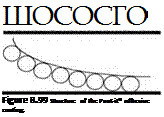The detachable adhesive systems that are currently available on the market are based on PSAs. A variety of detachable notes, similar to Post-it® notes, are produced by other manufacturers: in Germany, double-sided stretchable adhesive tape pads with a pull tab for removal (stretch release tapes) are sold as Power Strips ™ by Beiersdorf, or more recently, as ‘Scotch Commands’ by 3M.
In principle, PSAs can be formulated in such a way that they can be peeled off a solid surface without leaving any trace. This applies to the PSA tape ‘Tesafilm’ (Beiersdorf) when bonded to a glass surface. However, when bonded to paper its removal causes paper damage because the inherent strength of the paper, perpendicular to the surface, is rather low. One way of solving this problem could be to reduce the adhesive capacity of the PSA film, but this would result in a nonloadable,
and hence nonreliable, bonding. To make the best of this bad job, a multilayer coating (Figure 8.98) has been conceived that has been carefully adjusted to the requirements of the paper. Here, a special coating is applied to the writable side of the note, while on the reverse side an adhesion promoter is applied to ensure that the adhesive adheres well to this side of the paper. Finally, a pressure-sensitive microsphere-type adhesive is applied (i. e. microscopic adhesive ‘balls’).
Figure 8.99 shows in detail the multilayer coating that must be applied very carefully to ensure that the extent of surface area contact between the adhesive and substrate is very low, and that the microspheres are subject to maximum peel stress when peeled off, which enhances removal of the Post-it note. The adhesive must be formulated in such a way as to allow repeated repositioning without consuming the microsphere coating. A scanning electron microscopy image of the sticky surface of a Post-it note is shown in Figure 8.100.
It has become clear that this inconspicuous office supply staple, which was introduced in Germany as early as in 1981, is not based on a ‘weak adhesive’ but rather on sophisticated technology. However, the principle cannot be transferred arbitrarily to bonds that require higher strength values, and consequently another system was developed based on the effect ofstretched adhesive tapes. This had been described in an US patent in 1974 and dealt with the mounting of lenses into grinding machines (see Section 8.8.2), but did not attract much interest. This effect is easily reproduced by bonding a transparent, single-sided adhesive tape (available in every household) to a plastic or glass surface, for example, and allowing a ‘handle’ of adhesive tape to overlap on each side of the surface. When the free ends of the tape are stretched in parallel to the adhesive layer, the adhesive will undergo debonding from the end of the surface and along the tape borders. The tape then frequently tears up outside the bonded area. When applying adhesive to a highly stretchable carrier material (the 3M system), or when using thicker adhesive layers made from a highly stretchable PSA without a carrier (the Beiersdorf system), a double-sided adhesive

 |
Paper of Post-it Surface
Paper of Post-it Surface
|
Figure 8.100 Scanning electron microscopy image of the sticky surface of a Post-it® note (original magnification x 60). (Photo courtesy of 3M). |
tape that joins two rigid substrates can be released from the surfaces by stretching it in parallel to the bonding area. This process occurs due to the transverse contraction of the adhesive tape at elongation, which causes peeling effects in the adhesive layer perpendicular to the tensile force. This striking removal process has not yet been completely clarified, however, because another explanation suggests that extreme stretching impairs the rotation and vibration of the adhesive molecules, which are important requisites for ‘dynamic adhesion’ (see Chapter 3).
Stretch-release adhesive tapes have a high potential for new developments in technical applications. For example, they could allow the sound emission of piston engines to be reduced in cars ifthe valve cap were to be affixed to the piston engine by using stretch-release tapes instead of screws; this would significantly dampen the noise of the engine, more than 20% of which is emitted through the valve cap. Since, today, valves no longer require permanent maintenance, the greater challenge of reassembly of the valve cap would be outweighed by the noise-dampening effect of the bonded joint.
 24 января, 2016
24 января, 2016  Pokraskin
Pokraskin 
 Опубликовано в рубрике
Опубликовано в рубрике 